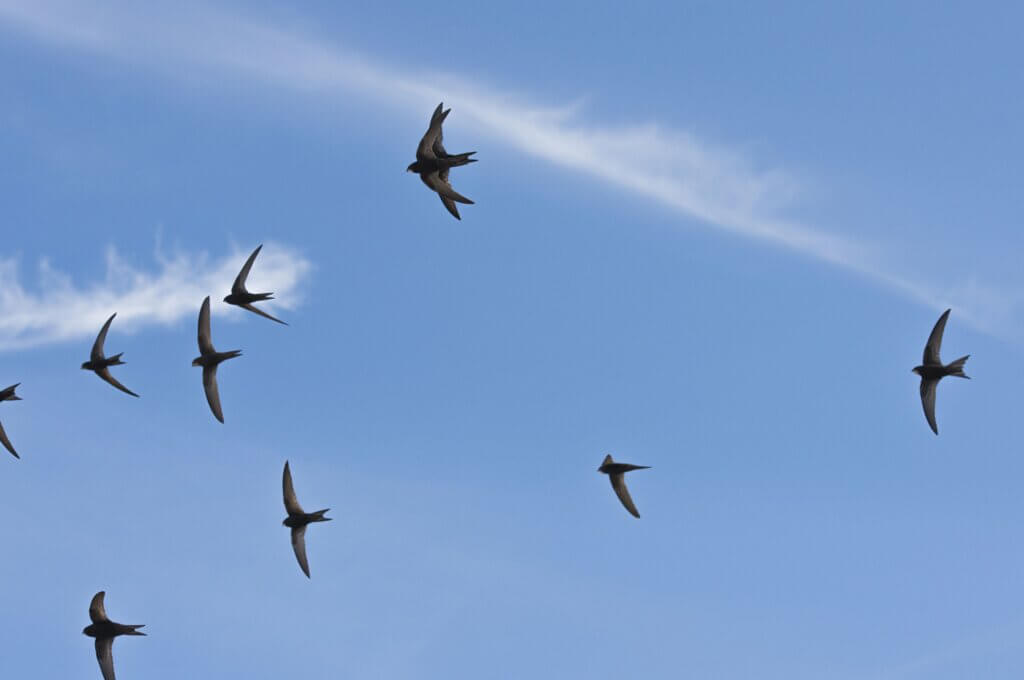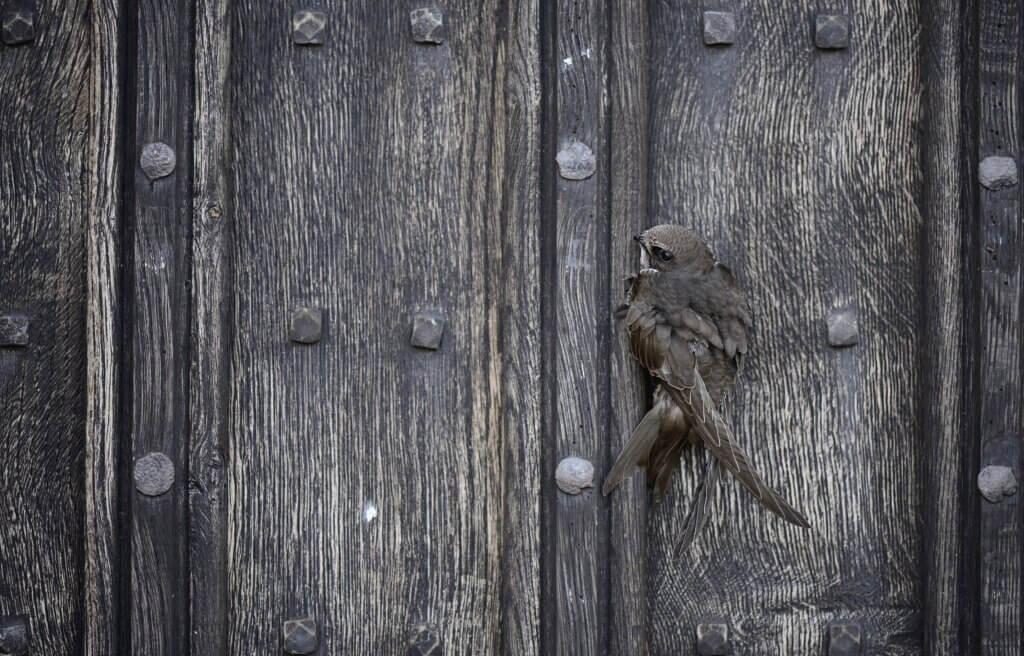
- Swift numbers plunged 58% between 1995 and 2018
- They are the fastest bird in level flight and rarely if ever touch the ground as they eat, sleep and mate on the wing
- The RSPB is calling on the public to help record where swifts are nesting to help us understand where the best places are to help these amazing birds.
Every year swifts make incredible journeys from Africa to the UK to nest in gaps in roof tiles and the eaves of our homes and other buildings.
These small but intrepid birds desperately need our help. Their numbers are falling sharply and in just 20 years more than half of our swifts have vanished. The RSPB believes loss of nest sites is at least partly responsible. They return from Africa to the same spot each year to breed in gaps under roof tiles and eaves but the way we build homes has changed and swifts are returning to discover their nest site has gone or access is blocked.
But there is something very easy the public can do to help. Together with our partners Action for Swifts, Natural Apptitude, Swift Conservation and the Swifts Local Network we’ve developed Swift Mapper; a web-based mapping system with mobile app.
By reporting where you see nesting swifts on Swift Mapper you’ll help to build a picture of where swift nest sites need to be protected and where it would be best to provide new nest sites.
Watch out for groups of swifts flying fast at roof height, often calling out loudly – this means they’re breeding nearby. Swifts nest in holes, so we’d also like to know if you see swifts entering holes in buildings – usually high up under the eaves.
The best time to look for nesting swifts is from late May to late July, around dusk on a warm, still evening or early in the morning.

RSPB UK Migrants Recovery Programme Manager, Guy Anderson said: “Swifts are true globetrotters, flying thousands of miles, but returning each year to nest in the very eaves of our homes. Just look at that Swift – back to its nest in your house, or local church tower, or old factory building – and think about it for a moment. It weighs about the same as a small chocolate bar. But it spent the winter in the skies over central Africa. Maybe over the Congo basin rainforest? Maybe over Malawi or Mozambique? It likely hasn’t stopped flying since it left its nest site last year.”
But numbers of these dauntless birds are plummeting, and they need our help.
If you are lucky enough to have nesting swifts close to your home – you can help. You don’t need a garden or even to leave your house. Simply by watching the skies from your living room window in the evening or over an early morning cup of tea, you can help us learn more and protect swifts’ future.”
Sightings of nesting swifts while out exercising are just as useful if you make a note of the location.
If you’re having trouble downloading the mobile app, try these tips from the App Store or Google Play. Make sure you also read our Swift Mapper FAQs.
Please don’t report swifts flying high in the sky, feeding over water or fields, or away from settlements on Swift Mapper. These birds could have travelled long distances and may not be local breeding birds. Please use BirdTrack instead to record these sightings.
Not sure you’ve seen a swift? Use the RSPB bird identifier to help confirm your sighting or learn more about the difference between swifts, swallows and house martins here.
If you’d like to do even more to help you can provide a home for swifts by putting up a swift box, encourage your local authority to make swifts welcome in your area and donate to the RSPB swift appeal.
Last year the RSPB recorded over 1,000 members of the public put up a swift box. The RSPB is working with developers such as the country’s largest housebuilder Barratt Developments plc to get more swift boxes installed in new homes. It’s still too soon to see nesting pairs in the bricks which have been installed as swifts typically take several years to find new nesting sites. We are hopeful that in just a few years we will have given swift numbers a significant boost by giving them permanent new homes across the country.

I’m seeing Swifts every day above my street – since 1 May.
I’m guessing they won’t feed the valuable breeding data gathered through to county bird recorders for county use, though (someone could let us know if otherwise – that would be great). My advice – keep putting it ALL in birdtrack with appropriate breeding codes so we can find it and utilise it to inform planning and conservation.
Hi Louise,
All the observations data can be downloaded from the site (and are completely ‘open’ without any restrictions). They can also be filtered out geographically if needed.
Work is underway to get them on the NBN Atlas too, should people prefer to access them through that route. That may take a little bit of time though given the current circumstances.
Thanks. It would be great if, when these initiatives are launched, a message was sent collectively to county recorders – its a tough life trying to keep up with all the new things being launched… we dont all spend every hour browsing the interweb randomly… there is a public list of all recorders for birds (and other taxa)… If it were my launch I would inform them….courtesy?
Arrogance?
One of ‘our’ returning swifts gave itself a very inauspicious start to the season by missing its target and crash landing into a plant pot. Fortunately, I witnessed the mishap so was able to rescue the disconcerted bird and relaunch it into the air, none the worse. Hopefully, it will have learnt from its mistake, otherwise it will soon be leaving the gene pool!
We are waiting with interest to see if the colony extends itself into a newly erected, purpose made swift box.
Sandra – fingers crossed!
We have had the pleasure of swifts in this area for 40+ years . This year , so far there are approximately 9 , normally 14 – 16 birds . This has saddened me greatly. Will be downloading the app .
Our Swift-calling equipment has just been activated for the six nest boxes in the Church Tower. Luckily a younger parishioner risks the steep stairs and balancing between the bells, he’s also a campanologist which helps. Just remember never to get in the bell loft at midday as the clock strikes without the appropriate PPE! More fingers crossed, Mark!
Having lived in same for 30 plus years i have watched swift numbers deplete over this time.this year to date none seen or heard.sad but hope they arrive soon but normally hear by now
Paul – thank you for your first comment here. Yes, I’d expect your Swifts to be back by now, maybe today or tomorrow…
I put up five nest boxes 4 years ago and played swift calls because we have Swift’s screeming overhead most years. Have managed to attract two but not in my boxes unfortunately but under tiles of house opposite but at least it’s a start they returned about 8 may so I will continue to try and attract more .
James – congratulations! Thank you for your first comment here.
Hi,
We have swifts nesting in our village of Sadberge near Darlington. I adore them. I’ve only seen 4 so far this year. Counted in excess of 20 on warm evenings last year! Have put up 4 swift boxes on my end gable wall. On day 2 of their arrival one few into my bathroom window enticed by the swift calls!! Had to gently lift it and set it free. Have now repositioned the swift calls directly under the box, rather than from the window. Less interest since sadly but playing sounds daily and hoping for some interest from the younger birds later. Please keep me updated on anything i can do to help,
Thanks Ruth
Only 3 in my immediate area this year. They nest under eaves of house opposite as council pulled down and rebuilt other houses without allowing for swifts about 15 years ago and swifts have swiftly declined. Understand major storm on their migration path in Europe last week killed thousands of swallows and swifts – numerous bodies everywhere. Terribly sad to just see three. Hope at least there will be a pair.
Swifts arrived in deepest Aberdeenshire yesterday, rather later than normal, first Swallows appeared on 20th April shortly after the Sand Martins.House Martins appeared during the first week of May. Two of the boxes on the house occupied by Swifts last year have been taken over by House Sparrows so we have put up some more.
Great to see them back ,was getting a bit worried, everything else expected has appeared other than the Spotted Flycatcher, fingers crossed for that.
Richard – excellent. Thank you for your first comment here. Good luck with the Spotted Flycatchers!
Spotted Flycatchers seen in the garden this morning, swifts back in boxes on the house and 16 seen over the village yesterday.